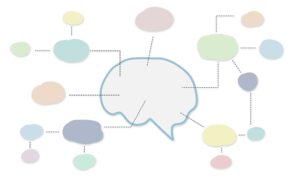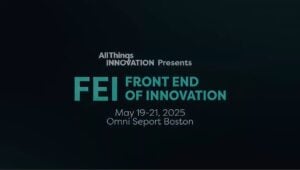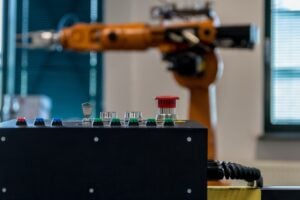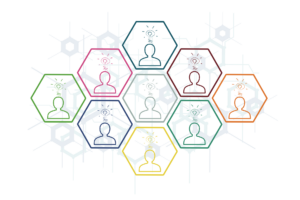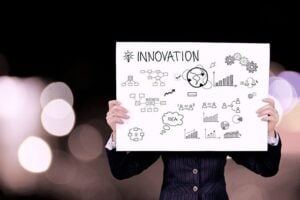KEY QUOTES
- “We’re looking at thousands upon thousands of organic consumer pieces of information being fed in, so right there, obviously much more compelling, right? Really grounded in consumer insight and the organic information that consumers are offering up on these product reviews in different forums digitally.”
- “The top 100 global innovators spend $720 billion on R&D every year, and a single digit percentage of those become commercial realities. It’s not just you. It’s hard. It’s really hard to do this.”
- “Artificial intelligence is not just another technology. It’s not just another hype. This is going to change mankind society in ways like the light bulb, industrialization and so forth.”
- “The work that we do in understanding humans and getting deeper insight into the true drivers of behavior is going to become increasingly important as AI accelerates a regression to the mean, we’re the champions of the future.”
- “Inclusive design is not a limitation, not a setback, but really helps to create great and better innovation. It allows you to be more creative, helps you think outside the box, and collaborate with a great amount of people.”
FULL TRACK SUMMARY
The Innovation Excellence & Best Practices Track at FEI25 offered a comprehensive look into modern innovation strategies, emphasizing the integration of advanced technologies like AI, the critical role of human insights, and the power of collaborative organizational structures. The sessions provided practical frameworks and real-world examples for aligning innovation efforts with overarching business goals and ensuring long-term growth.
Reinventing Innovation and Re-Thinking Possible at the Front End
Erica Norton from Hershey Company detailed how Hershey transformed its innovation process using ZS Associates’ AI-driven “Atlas” tool. This approach leverages thousands of organic consumer data points from online marketplaces and social media to generate product ideas, brand concepts, and partnership opportunities. The AI provides transparency into idea generation and produces high-quality outputs that outperform traditional ideation methods. Hershey applies Atlas for innovation within existing product forms, exploring new pack types, identifying co-branding, and developing new brands. It also aids in M&A due diligence and market intelligence by quickly providing consumer perceptions and competitive positioning.
Harvesting Innovation Through Collective Intelligence
This session differentiated “invention” (sowing seeds—ideas) from “innovation” (harvesting crops—commercial reality). The speaker emphasized that successful innovation requires systematic selection processes driven by economic value creation for customers, focusing on “dollars and cents” over just features and benefits. Organizations must assess internal capabilities and build external innovation ecosystems to bridge gaps for successful commercialization. A sobering statistic was shared: top global innovators spend $720 billion annually on R&D, yet only a single-digit percentage becomes commercial reality.
Driving The Integration of Emerging Technologies
Miele, a 125-year-old premium appliance manufacturer, discussed how it balances technological innovation with organizational adaptation to address the accelerating pace of change. Miele uses a dual approach: transforming traditional R&D units while creating specialized entities like the Emerging Technologies Lab to bridge the gap between startups and corporate structures. Successful integration requires cultural adaptation, overcoming resistance, and securing both top-down and bottom-up support. AI is viewed as a transformative force requiring early adoption to avoid disruption, with practical applications already delivering value in areas like market intelligence and technology scouting.
Emotional Connection: Why Gen AI Needs Continuous Insight Into Real Human Behavior
This session emphasized the critical role of non-conscious human insights for effective innovation, warning that generative AI models trained on their own outputs can experience “model collapse,” losing creativity and regressing to the mean. The solution proposed is the continuous injection of fresh human data, particularly non-conscious emotional and behavioral insights. Automated behavioral science, by quantifying attention, emotion, and non-conscious thought processes, can significantly accelerate innovation cycles from weeks to days while improving market prediction accuracy.
Designing for Everyone: The Power of Inclusive Innovation
This session highlighted that inclusive design is a fundamental approach for all product development, not just assistive technology, benefiting the 25% of adults who identify as having a disability while creating better innovation for everyone. Tatum Robotics’ work on a robotic hand for tactile communication for the deaf-blind community exemplified how co-creation with diverse users, understanding varied needs, and rapid iteration based on direct feedback lead to more effective and impactful products. Inclusive design requires customization and involves users from the earliest stages of development to avoid costly redesigns later.
Igniting Always-On AI Innovation
Lauren Collier and John Ferrera presented “Charlie,” an AI-powered innovation engine that transforms traditional innovation processes into an always-on, adaptive system. Charlie integrates proprietary knowledge, public insights, and internal data to synthesize information, detect trends, generate concepts, and create testable assets in minutes. This approach helps organizations accelerate innovation timelines from months to days and “10x” their exploration capabilities by testing concepts at scale. The session emphasized that speed is a necessity in today’s rapidly changing market, where customer needs are evolving 50 times faster than ever before.
Transformational Innovation Through Collaboration
This session showcased Welch’s Greenhouse, an internal cross-functional incubator designed to drive transformational innovation through collaboration across departments. Unlike traditional isolated innovation teams, Welch’s intentionally built cross-functional teams with representatives from finance, HR, product development, and marketing to create a two-way learning stream and operational efficiencies. Successful innovation requires regular cross-functional meetings, rapid prototyping, and early involvement of all stakeholders (including legal and regulatory). The approach emphasizes building trust, embracing constraints creatively, and maintaining psychological safety while working through uncertainty. The Greenhouse manages innovations through launch and beyond, often balancing a portfolio with 70% focused on commercialization within three years and 30% on longer-term, higher-risk innovation.
KEY TAKEAWAYS
- AI Accelerates, Human Insights Elevate: AI tools like Atlas and Charlie dramatically increase the speed and scale of innovation by synthesizing data and generating concepts, but continuous injection of fresh, non-conscious human behavioral data is crucial to prevent “model collapse” and ensure creativity and market relevance.
- Inclusive Design Drives Broader Value: Designing with, not just for, diverse user groups, including those with disabilities, expands market reach and leads to more universally effective and impactful products, proving that inclusive approaches are a strategic business advantage.
- Strategic Alignment and Economic Value are Paramount: Innovation efforts must be explicitly aligned with clear strategic objectives and driven by the economic value they create for customers (“dollars and cents”), moving beyond just features and benefits to ensure commercial viability and successful “harvesting” of ideas.
- Cross-Functional Collaboration and Rapid Iteration are Essential: Breaking down silos and fostering cross-functional collaboration from the earliest stages, combined with rapid prototyping and iterative testing, accelerates decision-making, uncovers blind spots, and builds organizational alignment and trust for innovation.
- Organizational Adaptation is Key for Emerging Technologies: Successfully integrating emerging technologies like AI requires not just technological innovation but also significant cultural and organizational adaptation, including creating specialized agile units and building “coalitions of the willing” to overcome resistance and drive change.
Delivery on the Event Focus:
Aligning Innovation with Business Strategy:
This track directly addressed aligning innovation with business strategy by showcasing how leading organizations are integrating innovation into their core business processes. Speakers demonstrated how AI-powered tools ensure innovations are grounded in consumer insights and market realities, aligning them with manufacturing capabilities and brand equities. The emphasis on understanding the economic value created for customers underscored that innovation must directly contribute to business outcomes. The sessions highlighted the strategic importance of dual innovation structures, balancing sustaining and transformational efforts to serve both immediate business needs and future growth opportunities. Inclusive design was also presented as a strategic advantage, tapping into underserved markets and creating universally better products.
Delivery on the Event Theme:
Harvesting Innovation & Sowing Seeds of Future Growth:
The track consistently delivered on the theme of “harvesting innovation and sowing seeds of future growth.” It showed how companies are “harvesting” insights from vast consumer data pools through AI and from existing knowledge investments, while simultaneously “sowing seeds” for future growth by exploring white spaces, new brand development, and emerging distribution models. The agricultural metaphor of invention as “sowing the seed” and innovation as “harvesting the crop” was central. The focus on protecting resources for future-focused work, continuous human data injection to prevent AI model collapse, and Welch’s balanced portfolio approach all underscored the commitment to nurturing long-term growth alongside immediate returns.
Action Items for Innovation Experts and Corporate Changemakers:
- Pilot AI-Driven Innovation: Evaluate your current ideation processes and pilot AI-driven innovation tools in specific areas (e.g., product development, partnership identification) to demonstrate value and accelerate timelines. Ensure these tools integrate diverse consumer data and align with strategic priorities.
- Integrate Automated Behavioral Science: Implement automated behavioral science and implicit testing methodologies to capture non-conscious consumer insights. Establish continuous human data collection systems to regularly inject fresh behavioral and emotional insights into AI models, preventing “model collapse” and fostering true creativity.
- Embed Inclusive Design Principles: Audit your design process to ensure diverse user perspectives, particularly from individuals with disabilities, are incorporated from the earliest stages of development. Adopt rapid prototyping and customization options to quickly iterate based on user feedback.
- Strengthen Cross-Functional Collaboration: Establish cross-functional innovation teams that meet regularly, breaking down silos and bringing all stakeholders (including legal, regulatory, and finance) into the process early to build shared understanding, address roadblocks creatively, and accelerate decisions.
- Assess and Adapt Organizational Structure: Evaluate your allocation of resources between sustaining and transformational innovation, considering separate but connected organizational structures with distinct cultures, metrics, and leadership behaviors. Develop AI competencies now to begin implementing AI tools in non-critical areas to build familiarity and demonstrate value.
Contributor
-
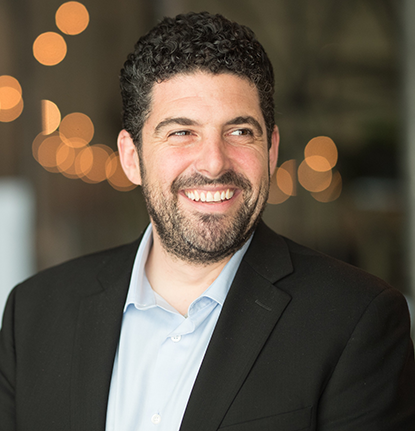
Seth Adler heads up All Things Insights & All Things Innovation. He has spent his career bringing people together around content. He has a dynamic background producing events, podcasts, video, and the written word.
View all posts












